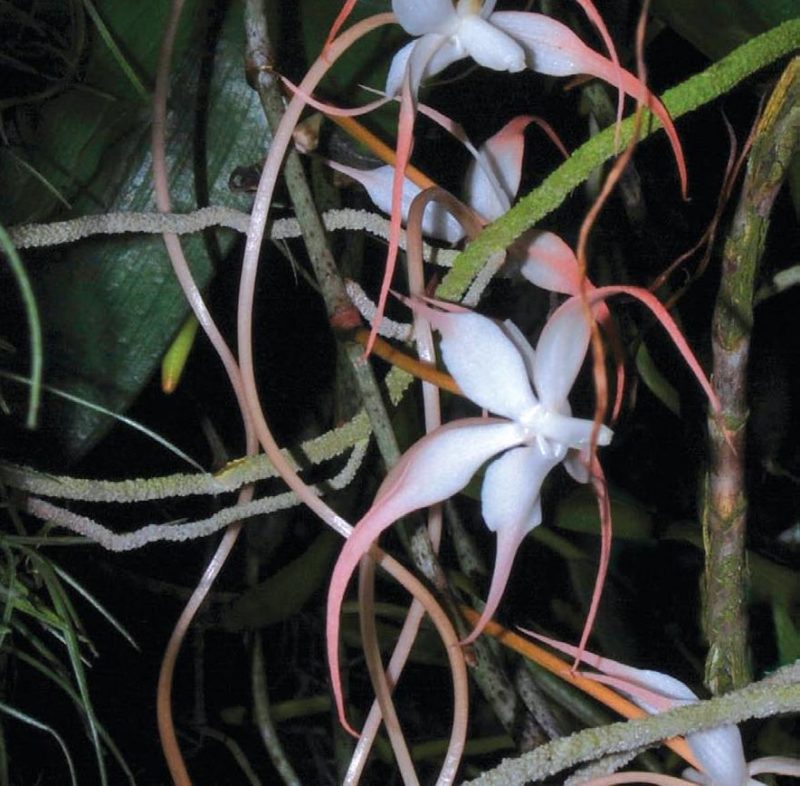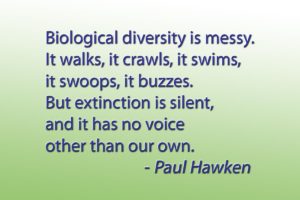
Extinction of species – the ultimate conservation challenge
Although I try very hard to keep up with news related to orchid conservation, deforestation, and species extinction, the news can be overwhelming. The idea of species extinction is difficult to face, particularly when we think of a species as cute and cuddly-looking as the panda in the picture above, or when it concerns the loss of one of our beloved orchid species.
From time to time the AOS Orchids magazine features an article about endangered orchid species. I must confess, I don’t read my issues from cover to cover. Every timeone arrives in my mailbox, I promise myself I will read all of it. But all too often I only flip through it, thinking “OK … later”.
One of those instances of “later” occurred recently. Last week, while heading out the door to an appointment, I decided to take something to read. I grabbed the first thing at hand, which happened to be the October 2015 issue. What a fortunate little accident that turned out to be. This particular issue contained an article written by Brenda Oviatt and Bill Nerison of Botanica LTD. Some may remember that they were our speaking guests for our February 2014 meeting.
Species facing extinction – and that includes orchids
The title of the article was Aerangis maireae . But actually it was the subtitle, Facing Extinction, that caught my eye. Extinction?! That sounds rather final — something that is supposed to happen only to dinosaurs. In fact, it has happened, and continues to happen at a rapid rate, to many species, including orchids.
We should be thinking of this more often. After all, we know that we are in an era of rapid extinction called the Sixth Mass Extinction, and it is occurring at a rate faster than was seen during the decline of the dinosaurs. That, alone, ought to give us pause.
This orchid was the last of its kind, and the only one in the world!
The article tells the fascinating story of an African species Aerangis maireae (MY-ra-ee), named after Maire Spurrier, who rescued the plant from a felled tree at a Tanzanian logging site in 1990. This was the only specimen found and known to exist in the entire world. Brenda and Bill relate the journey this orchid took, and how they came to be in possession a piece of the original plant, which they are now able to grow in their greenhouse.
 Shortly after its dramatic rescue at the logging site, the plant was given to Joyce Stewart and shared with Isobyl la Croix in the 1990’s. A number seedlings were produced, but it is not known how many of them are still alive today as they were distributed around the world. Brenda and Bill were fortunate in being able to obtain a few of them.
Shortly after its dramatic rescue at the logging site, the plant was given to Joyce Stewart and shared with Isobyl la Croix in the 1990’s. A number seedlings were produced, but it is not known how many of them are still alive today as they were distributed around the world. Brenda and Bill were fortunate in being able to obtain a few of them.
Brenda and Bill are doing everything possible to keep this plant from going extinct. Although they have not been able to produce viable seeds at Botanica LTD, they have been famously successful at preserving many other angraecoids through ex-situ propagation.
The biggest challenge we face is to keep species from going extinct
Through the fascinating story of this one orchid species, the authors bring to light the need for conservation in general. I highly recommend this article to anyone interested in conservation. It gives an excellent overview of the creation of CITES (Convention on International Trade in Endangered Species) and the difficulties involved with collecting and protection. A number of dedicated individuals and organizations have been hard at work for decades, trying to preserve as many species as they can before logging and mining destroy the habitats forever. We needed these stringent rules to protect endangered species from over-collecting and poaching, but methods to preserve and rescue are still without easy answers, even years after CITES came into effect.
Orchid lovers – all hands on deck – here is what we can do
Brenda and Bill urge all of us to protect our prized species in our own collections, and to give them the care needed for their preservation. This message is a very personal one for me. I have a number of plants which I brought back from the Philippines in the eighties. Only over the last few years have I developed a true appreciation for how unique my situation is, having jungle-collected plants in my collection. These species are very precious, not only to me, but to the orchid world in general. I may have had some unique varieties. After all, orchids very from region to region. Sad to say, I have lost many of them over the years, due to diseases and to the difficulties of maintaining a hospitable environment for them. I can see the battle with extinction taking place in my own greenhouse. As a result, I now resolve to give the care of my orchids top priority and, whenever possible, share keikis with others.
 At the end of the article the authors make a plea for us to care more about protecting endangered species in general. They point out that this mass extinction is human-caused and state that the “five major reasons for this Sixth Mass Extinction are habitat destruction, pollution, invasive species, overpopulation of humans, and overharvesting by humans (i.e., hunting, fishing and gathering).” They question the practice of logging in critical habitats, and also touch on special issues in Africa such as civil wars, the thirst for natural resources, and the impact of foreign extractive industries leaving a wake of destruction and poverty.
At the end of the article the authors make a plea for us to care more about protecting endangered species in general. They point out that this mass extinction is human-caused and state that the “five major reasons for this Sixth Mass Extinction are habitat destruction, pollution, invasive species, overpopulation of humans, and overharvesting by humans (i.e., hunting, fishing and gathering).” They question the practice of logging in critical habitats, and also touch on special issues in Africa such as civil wars, the thirst for natural resources, and the impact of foreign extractive industries leaving a wake of destruction and poverty.
Rainforest Trust is protecting wildlife habitat in Africa
After reading this article, I went to the Rainforest Trust’s website to learn about their preservation efforts in Africa. I learned that their new project is west of Tanzania in the Democratic Republic of the Congo. The Rainforest Trust is working to establish the 1,194,507-acre Balanga Forest Reserve. The proposed protected area will strategically expand protection for wildlife beside the Lomami National Park. Together these two sites will preserve 3.4 million acres and, of course, many orchid species. The area in Tanzania where the Aerangis maireae was found may have been destroyed, but certainly we can say that some areas in this rich biodiversity of Africa are being preserved. We can all be proud that our society and many others in SWROGA have supported the Trust, and know that we are preventing extinction of orchids in at least some areas of the world.
Putting aside something for later is something we all do. Many things can be done quite well later. But for species facing extinction, there is no “later”. When they are gone – they are really gone. There will not be a second chance.![]()